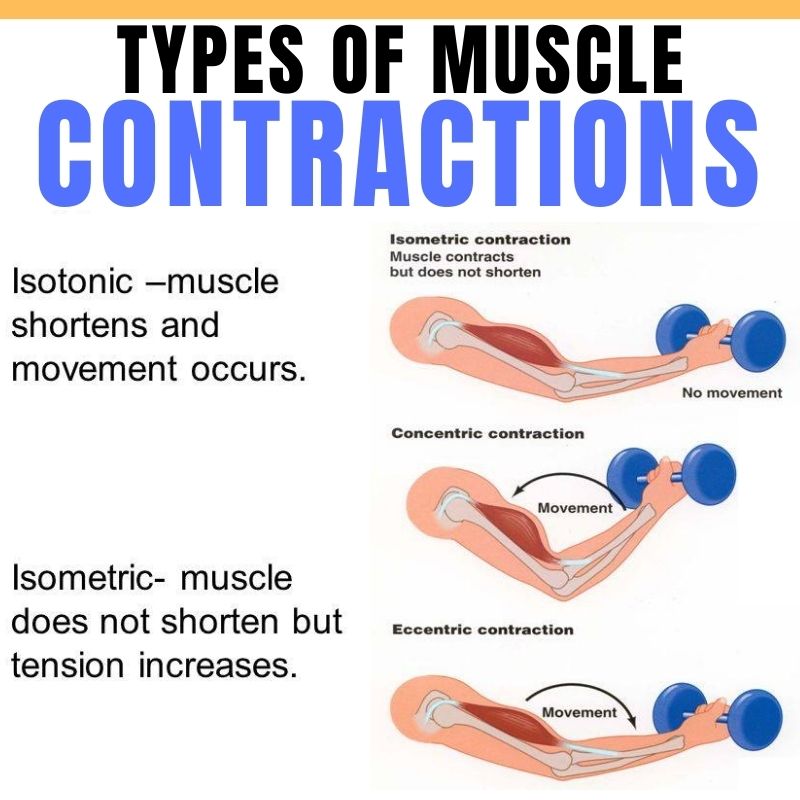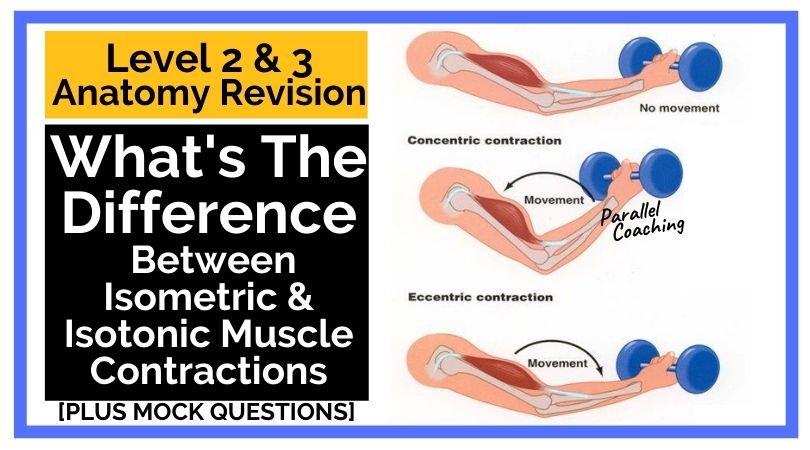In today’s video training, you’ll learn The Difference Between Isometric and Isotonic Muscle Contractions, including understanding Concentric and Eccentric contractions and applying these to exercises. This will help you in preparation for your Level 2 and Level 3 Anatomy and Physiology Exam as well as a FITPRO when programming for your clients.
You’ll discover:
- What do you need to know about the muscle contractions for your Level 3 anatomy and physiology exam?
- 6-minute Video Training explaining What’s The Difference Between Isometric and Isotonic Muscle Contractions?
- The difference between concentric and eccentric muscle contractions
- Test your knowledge with 3 Mock Questions and answers
What do you need to know about the muscle contractions?
The level 2 and Level 3 anatomy and physiology exams are both divided into 8 sections, whereby understanding the musculoskeletal system is one of these. This includes the understanding of how muscle contracts and allows for movement around a joint.
You can expect approximately 3-8 questions relating to this topic for your exam.
This is also important beyond the exam, for understanding how movement occurs and the types of contractions that are taking place in the muscles every time your client completes a repetition of an exercise.
Watch: What’s The Difference Between Isometric and Isotonic Muscle Contractions?
What is an Isometric Contraction?
Iso = Same
Metric = Length
Isometric literally means “same length”
During this type of contraction, the muscle is contracted, so the muscle is “switched on” and the actin and myosin are actively working. However the origin and insertion of the muscle stay the SAME LENGTH away from each other, and there is no movement at a joint
Examples of this include holding a plank position or doing a wall sit/ squat hold. You are contracting the prime mover muscle, but the length of the muscle doesn’t change

What is an Isotonic Contraction?
Iso = Same
Tonic = Tonality
During this type of contraction, the muscle is contracted, so the muscle is “switched on” and the actin and myosin are actively working. However the muscle CHANGES LENGTH, as the Origin and Insertion move towards and away from each other, creating movement at a joint.
An example of this is a Biceps Curl, a Press Up, a Squat … any exercise that has joint movement
There are two types of contraction inside the isotonic heading:
Concentric
and Eccentric
What is a Concentric Contraction?
This is a type of Isotonic Contraction whereby the muscle is on and contracted but SHORTENING
The actin and myosin move over each other to bring the insertion and origin closer together
For example, in a Biceps Curl, the biceps brachii (prime mover) is concentrically contracting as you lift the dumbbell towards the shoulder.
What is an Eccentric Contraction?
This is a type of Isotonic Contraction whereby the muscle is on and contracted but LENGTHENING
The actin and myosin move over each other to move the insertion and origin further apart
For example, in a Biceps Curl, the biceps brachii is eccentrically contracting as you lower the dumbbell towards the floor.
NOTE that this is the same prime mover muscle (not a different muscle), it is still contracted and holding the weight of the dumbbell but now lengthening in the lowering phase
Test your knowledge with 3 Mock Questions
Look at the Muscle Contractions Anatomy and Physiology Mock questions below and jot down your answer on scrap paper or as a note in your phone.
Then scroll down to reveal the answers.
1) Which of the following best describe an Isometric Contraction?
A. The muscle is relaxed and lengthened
B. The muscle is contracted and shortening
C. The muscle is contracted and lengthening
D. The muscle is contracted and stays the same length
2) What movement occurs during a concentric contraction of the quadriceps?
A. Knee Flexion
B. Knee Extension
C. Hip Extension
D. Plantarflexion
3) What is the umbrella terminology used for both concentric and eccentric contractions?
A. Isometric
B. Isotonic
C. Semitonic
D. Perimetric
Answers:
Q1: Answer = D
Q2: Answer = A
Q3: Answer = B
If you want more mock questions like this, then you can download more Free Mock Questions: DOWNLOAD NOW
Need More Help with your Level 3 Anatomy Revision?
For Trainee FITPROS Taking Their L3 Anatomy & Physiology Exam.
Learn, Revise & Pass Your Level 3 Anatomy & Physiology Exam In Under 10-hours
(Without Having To Spend Hours Revising Or Feeling Overwhelmed)
If you want to get your revision structured, learn everything you need to know, and feel confident on exam day, then click the link below:

Dedicated to More
Hayley “Isometric and Isotonic Muscle Contractions” Bergman
Parallel Coaching
P.S. You can also find us on the following platforms:
Instagram: Follow Now
Facebook: Like Our Page
Twitter: Tweet Us
YouTube: Subscribe Here
More Muscle Revision Blogs: HERE

